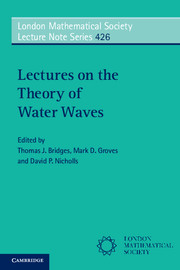Book contents
- Frontmatter
- Contents
- Contributors
- Preface
- 1 High-Order Perturbation of Surfaces Short Course: Boundary Value Problems
- 2 High-Order Perturbation of Surfaces Short Course: Traveling Water Waves
- 3 High-Order Perturbation of Surfaces Short Course: Analyticity Theory
- 4 High-Order Perturbation of Surfaces Short Course: Stability of Traveling Water Waves
- 5 A Novel Non-Local Formulation of Water Waves
- 6 The Dimension-Breaking Route to Three-Dimensional Solitary Gravity-Capillary Water Waves
- 7 Validity and Non-Validity of the Nonlinear Schrödinger Equation as a Model for Water Waves
- 8 Vortex Sheet Formulations and Initial Value Problems: Analysis and Computing
- 9 Wellposedness and Singularities of the WaterWave Equations
- 10 Conformal Mapping and Complex Topographies
- 11 Variational Water Wave Modelling: from Continuum to Experiment
- 12 Symmetry, Modulation, and Nonlinear Waves
Preface
Published online by Cambridge University Press: 05 February 2016
- Frontmatter
- Contents
- Contributors
- Preface
- 1 High-Order Perturbation of Surfaces Short Course: Boundary Value Problems
- 2 High-Order Perturbation of Surfaces Short Course: Traveling Water Waves
- 3 High-Order Perturbation of Surfaces Short Course: Analyticity Theory
- 4 High-Order Perturbation of Surfaces Short Course: Stability of Traveling Water Waves
- 5 A Novel Non-Local Formulation of Water Waves
- 6 The Dimension-Breaking Route to Three-Dimensional Solitary Gravity-Capillary Water Waves
- 7 Validity and Non-Validity of the Nonlinear Schrödinger Equation as a Model for Water Waves
- 8 Vortex Sheet Formulations and Initial Value Problems: Analysis and Computing
- 9 Wellposedness and Singularities of the WaterWave Equations
- 10 Conformal Mapping and Complex Topographies
- 11 Variational Water Wave Modelling: from Continuum to Experiment
- 12 Symmetry, Modulation, and Nonlinear Waves
Summary
Waves on the surface of the ocean are a dramatic and beautiful phenomena that impact every aspect of life on the planet. At small length scales, ripples driven by surface tension on the surface of these “water waves” affect remote sensing of surface and underwater obstacles. At intermediate scales, waves on the surface and the interface between internal layers of water of differing densities affect shipping, coastal morphology, and near-shore navigation. At larger lengths, tsunamis and hurricane-generated waves can cause devastation on a global scale. Additionally, water waves play a crucial role at all length scales in the exchange of momentum and thermal energy between the ocean and atmosphere that, in turn, affect the global weather system and climate.
From a mathematical viewpoint, the water wave equations pose severe challenges for rigorous analysis, modelling, and numerical simulation. The governing equations are widely accepted and there has been substantial research into their validity. However, a rigorous theory of their solutions is extremely complex due not only to the fact that the water wave problem is a classical free boundary problem, where the domain shape is unknown, but also because the boundary conditions are strongly nonlinear. The level of difficulty is such that the theory has merely begun to answer the fundamental questions that must be addressed before our understanding can be considered “adequate.” For instance, it is well known that the very existence of solutions to the equations that describe fluid motion, even in the absence of free boundaries, is one of the most difficult unanswered questions in mathematics (indeed it is one of the Clay Mathematics Institute Millennium Prize Problems).
In July and August of 2014 a four-week programme on the theory of water waves was convened at the Isaac Newton Institute for Mathematical Sciences in Cambridge, with over 50 leading researchers in the theory of water waves from fifteen countries across the globe. The aim was to share recent research ideas and identify strategies for future directions. The key themes of the conference were (a) the initial value problem (well-posedness, singularities, numerical methods, simulations), (b) existence of classes of waves (travelling waves, standing waves, multi-periodic waves, solitary waves, patterns, waves with vorticity and viscosity), (c) stability of waves (analytical and numerical methods, wave interactions, rogue waves, energetic stability), and (d) dynamical systems approaches (variational principles, modulation, centre-manifolds, spatial dynamics, bottom topography).
- Type
- Chapter
- Information
- Lectures on the Theory of Water Waves , pp. xiii - xivPublisher: Cambridge University PressPrint publication year: 2016



